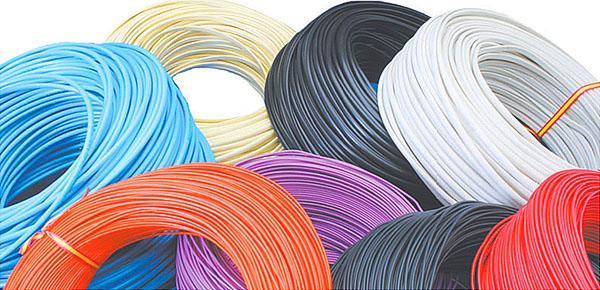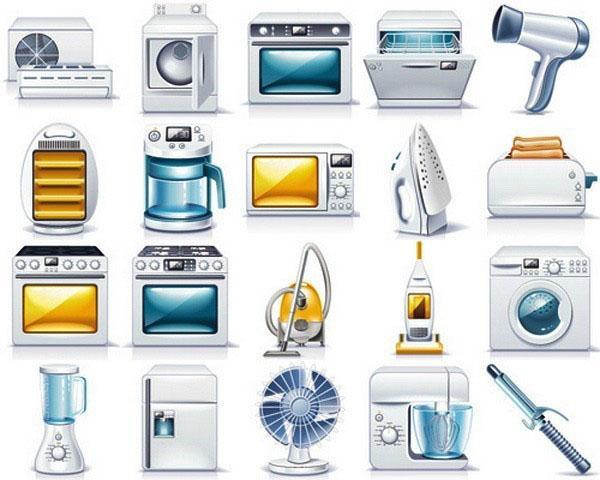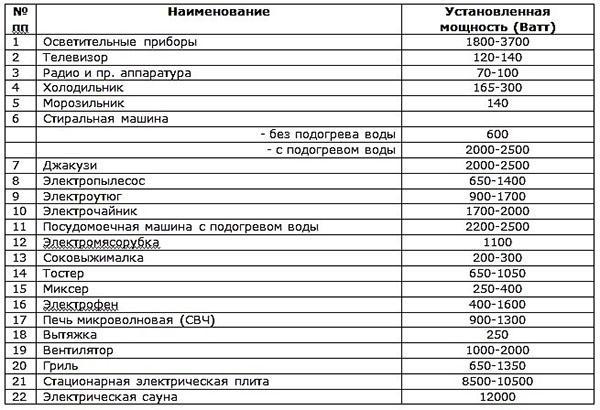We select the correct wire cross-section for current and power
 The wire cross-section for current and power are parameters that indicate the purpose of a particular cable. In other words, where the wire can and cannot be used.
The wire cross-section for current and power are parameters that indicate the purpose of a particular cable. In other words, where the wire can and cannot be used.
Data collection

First of all, you need to collect data on those devices to which the wires will go. Such data are called passport data, they must be written in the technical passport for the device. It contains data such as:
- device model;
- voltage;
- power consumption;
- certificate mark;
- the country of manufacture;
- date of manufacture;
- recycling sign;
- protection class and so on.
In addition, if, say, you have lost the registration certificate, then special plates are placed on the devices or stickers are glued. They display basic data. Including the power consumption, which is what we need. You can choose the wire cross-section by power and without it.
If there is no label with a sticker left, but you remember the model (it can be written on the case), then it doesn't matter. Try to search the Internet for information about the device. In a pinch, use the average statistics. There is a special table of indicative power consumption of various appliances, such as: drill, toaster, refrigerator, washing machine, air conditioner, and so on.
There is only one important nuance here. See the table gives the power range? It's hard to guess what to choose.
Always take the maximum!
When you start calculating the cable cross-section by power, as a result you will get an overestimated power of the device. This is very good, as a result you will need a cable with a large cross-section. Such cables heat up a little and, accordingly, work longer.
If the device requires more power, then a wire with a small cross-section will simply burn out.
Load method
As already mentioned, the load is the device. It can be one, or it can be several. No matter how many there are, always add up all the powers of the devices to which you connect the conductor. All these powers should be expressed in only one unit of measure! In watts or kilowatts, otherwise you will get confused in the calculations.
"Kilo" is multiplication by a thousand. 1 kW = 1000 W.
If the power values of the devices are different, then we make them the same - we translate. Let's say that one device consumes 100 W and the other 3.5 kW. We leave the value of the first untouched, and translate the value of the last, we get 3500 watts. If you want to convert watts to kilowatts, then divide by a thousand.
The power was calculated. Now we select the section of the cable. The table of cable power by section is presented below. There is nothing complicated in it, since you just need to select the columns where the phases are indicated. If you have one phase in the network, then we take a voltage of 220 volts. If three - 380 volts.
Then we find a number that is slightly more than the power that you counted. Found it? On the left, the corresponding conductor cross-section and its diameter are indicated. This is the cable you need.If you have at hand a table of cable cross-sections for power, then no difficulties will arise.
In this table, the values for copper and aluminum conductors are different. What kind of vein do you need - look in such columns.
Sometimes difficulties arise with the choice of the material from which the cable cores are made. Copper is used as wiring in houses and apartments. Copper wires are believed to be flexible, practical and reliable. True, they are more expensive than aluminum cables. Of course, if a copper conductor has a large cross-section (when there is a high load in the house), then it can no longer be called flexible. And the price will be higher. Therefore, in such cases, feel free to take aluminum wires - a good savings.
By power and length
 The choice of cable cross-section in terms of power and length is done a little differently. It happens when the conductor is several tens or even hundreds of meters long. The losses in the cables themselves have to be taken into account, otherwise the energy may not be enough for the equipment. There is another table that will suggest further actions, taking into account all losses.
The choice of cable cross-section in terms of power and length is done a little differently. It happens when the conductor is several tens or even hundreds of meters long. The losses in the cables themselves have to be taken into account, otherwise the energy may not be enough for the equipment. There is another table that will suggest further actions, taking into account all losses.
You need to know the power that is allocated to a house or building. The allocated power is the power of all equipment that operates in the house. And the distance from the pole to the building where the cable comes from. This distance is easy to measure yourself.
Be sure to take a small amount of wire gauge before wiring.
With a larger cross-section, the wire heats up less and the insulation, along with it. This means that the likelihood of a fire or short circuit is reduced. Also, it often happens that the number of appliances in the house can be added. Let's say you put in a refrigerator, air conditioner and an electric stove. A year later, they decided to buy a computer, a toaster, two TVs and something else that runs on electricity. The wiring simply does not have enough power to withstand so much equipment. You will have to make sure that the powerful equipment is not turned on at the same time, or completely change the wiring. Or you can simply lay the wiring in advance with a cross-sectional margin. It's more rational: you won't have to suffer later.
Current calculation
It is also possible to select the current cable cross-section. To do this, it is necessary to carry out the same collection of data on stickers, plates or technical data sheet. Only now we do not need power in watts, but current in amperes. The characteristics indicate the current that is maximally consumed by the device.
We collect data from all devices again and summarize. And we also translate everything into one unit, similarly: 1mA (milliampere) = 0.001 A and 1A = 1000 mA. For example, 2.3A is 2300 mA. It's just that sometimes for some reason they indicate it in milliamperes.
The very first table shown above can determine the cross section not only by the number of watts. It is also a table for determining the cross-section of wires for power and current at the same time. That is, you have to work with her again. Please note: numbers are not all. For example, you have a current draw of 25 amps and you need copper wire. This number is not in the table. We choose a larger value. It is equal to twenty-seven amperes - therefore, be guided. It turns out that the required current section of the cable is 4 square millimeters.
Never choose a lower value to save money! In the best case, the circuit breaker will trip, stopping the supply of electricity. If there is no such machine, and this is the worst case, then there is a high probability of equipment failure or even a fire. Don't skimp on the safety of your home and yourself.
Wiring
However, when current flows through the wire, the conductor heats up. A lot of current - a lot of heat. What we are talking about: laying the wire can be closed or open. Closed is when the wire is under a special pipe. Open - when it is not covered by anything, that is, a bare wire attached to the wall.
Here you can cheat. The temperature will be different for different conductor cross-sections, even if the current value remains the same.This means that if the cable is laid open, then a smaller section is quite acceptable. The heat will go into the air, and the wire, accordingly, will cool down.
Wires with a small cross-section, in pipes, cable channels or a wall, will not be able to cool down - the heat has nowhere to go. Therefore, when the wire is covered, only a larger cross-section is needed, otherwise the insulation will deteriorate. There is also a table that will help you choose a conductor, taking into account its laying. The principle remains the same: copper or aluminum conductors, current and power.
Cable routing table:
But you can get confused. For example, we need a copper conductor with a power of 7.3 kW (7300 W). The network is single-phase, we will put it closed. We look at the plate. We remember that everything is taken according to the maximum values. We find the number 7.4 kW. And we see that the required section is 6 square millimeters.
Or, we want to lay the aluminum conductor openly. We know that the dispensing current is 40 amperes. The table contains the number 39. You can't! We take more - sixty amperes. We see that we will buy a conductor with a cross section of ten square millimeters. And if we lay it closed, then 16. And we were not mistaken, and there is a reserve. Before buying a wire, take a caliper and the first plate with you. Just in case, check: is it the same diameter? If, in fact, it turns out to be less than stated, then do not take this wire!